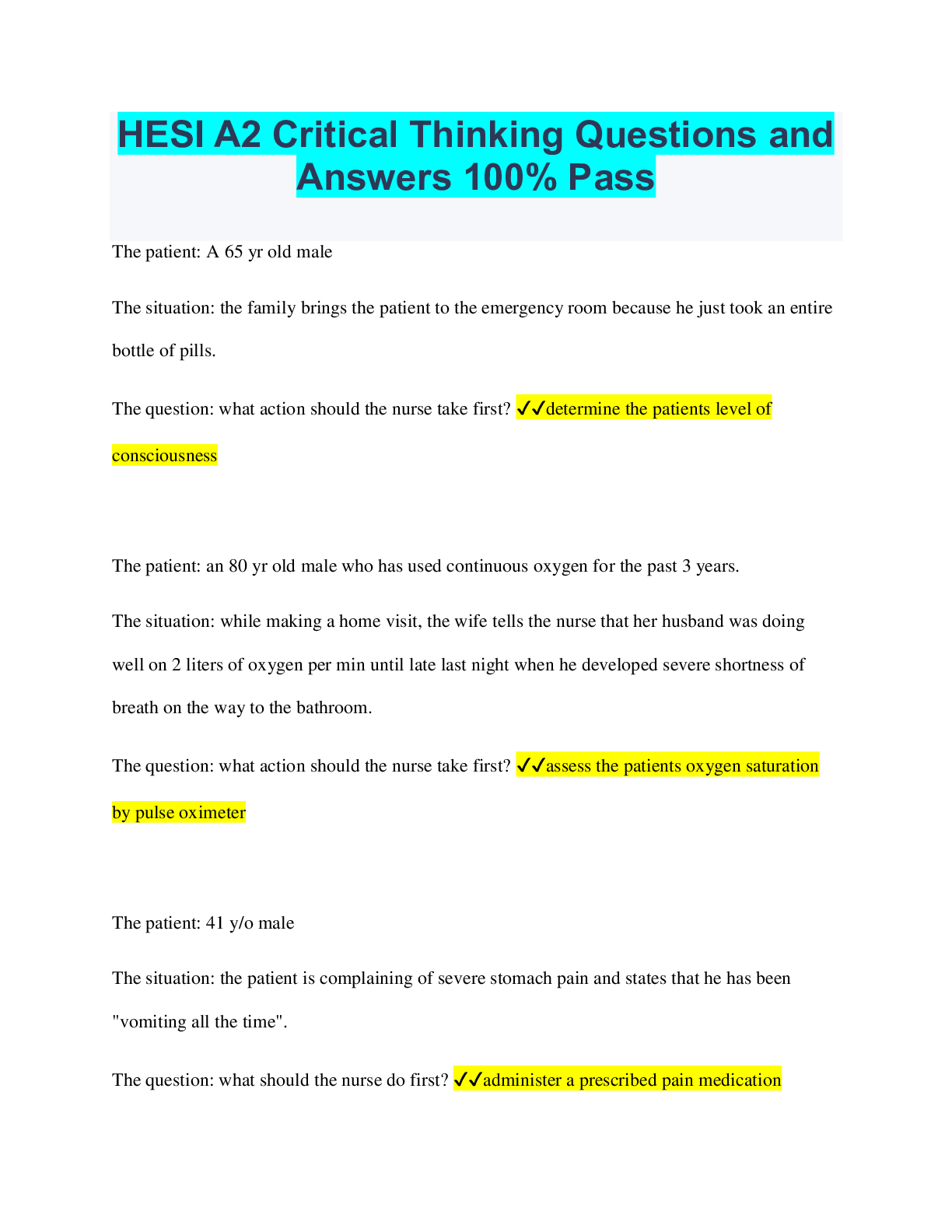*NURSING > QUESTIONS & ANSWERS > Atrial Dysrhythmmias Study Questions (All)
Atrial Dysrhythmmias Study Questions
Document Content and Description Below
Atrial Dysrhythmmias Study Questions A patient who is otherwise healthy is experiencing premature atrial contractions (PACs). The patient asks what could be causing the PACs. Which is the best respo... nse by the nurse? "Your low-protein diet." "Your coffee and cigarette use." "Your family history of diabetes." "Your sedentary lifestyle and high-fat diet." - ✔✔"Your coffee and cigarette use." In a normal heart, a PAC can result from the use of caffeine or tobacco. A low-protein diet is not associated with the development of PACs.Diabetes is not generally linked to the formation of a PAC in the normal heart.A sedentary lifestyle and a high-fat diet are typically not associated with PACs. Which statement describes a patient who has an ECG reading with a ventricular rate of 120 and loss of the atrial kick? The patient experiences a decrease in cardiac output because of ineffective atrial contractions. The patient experiences no symptoms associated with a ventricular rate of 120 and loss of atrial kick. The patient experiences loss of consciousness and requires CPR because the heart is not perfusing the body. The patient experiences an increase in cardiac output because the increase ventricular rate supports the loss of atrial kick. - ✔✔The patient experiences a decrease in cardiac output because of ineffective atrial contractions. The high ventricular rates (greater than 100 beats/minute) and loss of the atrial "kick" (atrial contraction reflected by a sinus P wave) that are associated with atrial flutter decrease cardiac output. An increased ventricular rate and loss of atrial kick is characteristic of an atrial flutter, which may have serious clinical consequences including heart failure. An increased ventricular rate and loss of atrial kick is characteristic of an atrial flutter, which is not associated with loss of consciousness. High ventricular rate and loss of atrial kick will not result in an increase in cardiac output. A patient is diagnosed with atrial fibrillation. Which ECG findings does the nurse expect? Atrial rate 80 bpm/regular ventricular rhythm Atrial rate 400 bpm/consistent ventricular rate Atrial rate 200 bpm/ventricular rate irregular and variable Atrial rate of 580 bpm/variable and irregular ventricular rate - ✔✔Atrial rate of 580 bpm/variable and irregular ventricular rate During atrial fibrillation, the atrial rate may be as high as 350 to 600 beats/minute. Ventricular rate varies and the rhythm is usually irregular. In a patient with atrial fibrillation, the atrial rate would be expected to be higher than 80 bpm, and the ventricular rhythm is typically not regular. Although the atrial rate in a patient with atrial fibrillation may be 400 bpm, the ventricular rate is not typically constant. The atrial rate is expected to be greater than 200 bpm for a patient with atrial fibrillation. The nurse is caring for a patient with shortness of breath, dizziness, and chest pressure. The nurse notes a thready, irregular pulse, and an ECG that indicates atrial fibrillation. Which action would the nurse take first? Cardiovert at 360 joules Give narcotic pain medicine Administer a dose of warfarin Obtain STAT chest radiograph - ✔✔Administer a dose of warfarin The nurse would administer warfarin. Anticoagulation therapy is necessary because the procedure can cause blood clots to dislodge, placing the patient at risk for stroke. The nurse would expect to cardiovert a patient with symptomatic atrial fibrillation, but that would not be the first action. Narcotics would treat the chest pressure but would not correct the patient's abnormal heart rhythm. A patient with atrial fibrillation and dyspnea may require a chest x-ray, but that would not correct the patient's dysrhythmia. Which nursing intervention is a priority for Ms. Keim? Recommend a vigorous exercise routine Recommend less coffee and stress relief Obtain an order for calcium channel blockers Prep Ms. Keim for radiofrequency catheter ablation - ✔✔Recommend less coffee and stress relief Ms. Keim is experiencing signs of premature atrial contractions (PACs), as confirmed by ECG. Treatment relies on managing the underlying cause(s), in this case caffeine consumption and stress. Ms. Keim is experiencing signs of pre [Show More]
Last updated: 2 years ago
Preview 1 out of 10 pages

Buy this document to get the full access instantly
Instant Download Access after purchase
Buy NowInstant download
We Accept:

Reviews( 0 )
$10.00
Can't find what you want? Try our AI powered Search
Document information
Connected school, study & course
About the document
Uploaded On
Jan 30, 2023
Number of pages
10
Written in
Additional information
This document has been written for:
Uploaded
Jan 30, 2023
Downloads
0
Views
140


























